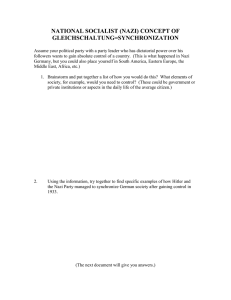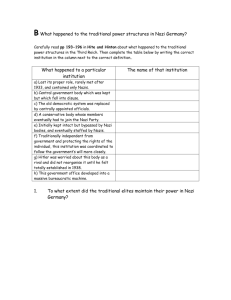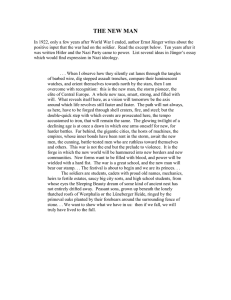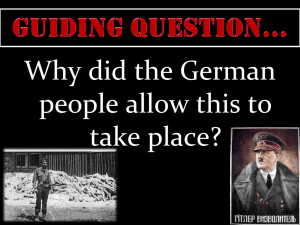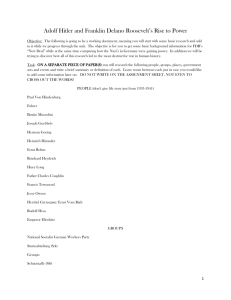The Re-Education Of the German People
advertisement
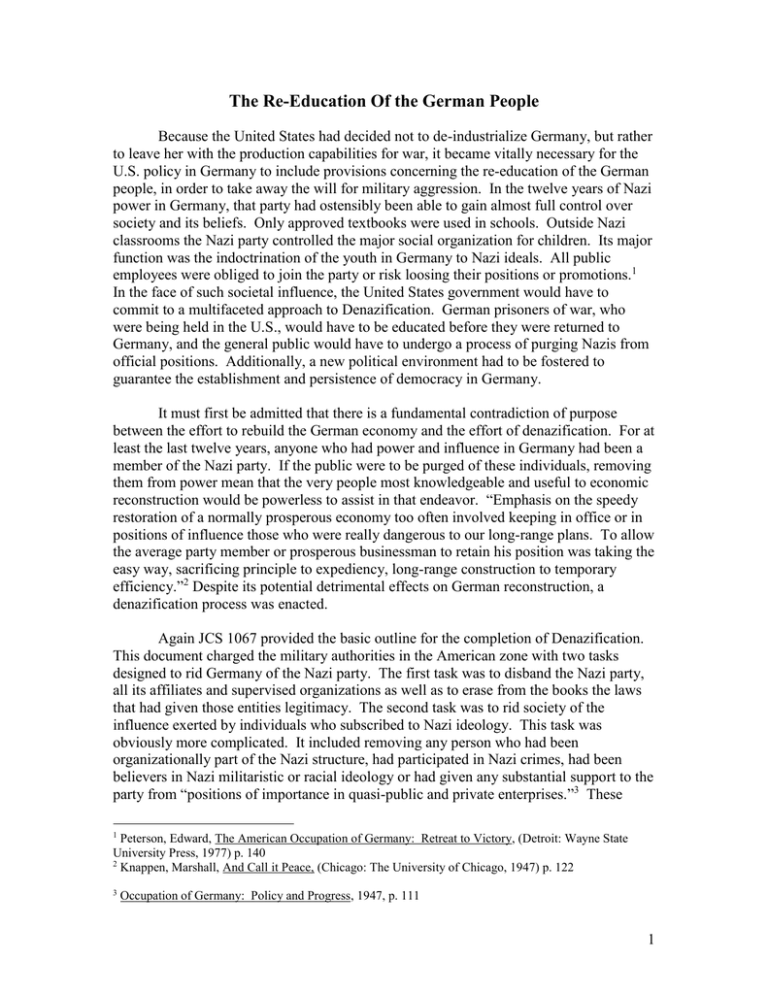
The Re-Education Of the German People Because the United States had decided not to de-industrialize Germany, but rather to leave her with the production capabilities for war, it became vitally necessary for the U.S. policy in Germany to include provisions concerning the re-education of the German people, in order to take away the will for military aggression. In the twelve years of Nazi power in Germany, that party had ostensibly been able to gain almost full control over society and its beliefs. Only approved textbooks were used in schools. Outside Nazi classrooms the Nazi party controlled the major social organization for children. Its major function was the indoctrination of the youth in Germany to Nazi ideals. All public employees were obliged to join the party or risk loosing their positions or promotions.1 In the face of such societal influence, the United States government would have to commit to a multifaceted approach to Denazification. German prisoners of war, who were being held in the U.S., would have to be educated before they were returned to Germany, and the general public would have to undergo a process of purging Nazis from official positions. Additionally, a new political environment had to be fostered to guarantee the establishment and persistence of democracy in Germany. It must first be admitted that there is a fundamental contradiction of purpose between the effort to rebuild the German economy and the effort of denazification. For at least the last twelve years, anyone who had power and influence in Germany had been a member of the Nazi party. If the public were to be purged of these individuals, removing them from power mean that the very people most knowledgeable and useful to economic reconstruction would be powerless to assist in that endeavor. “Emphasis on the speedy restoration of a normally prosperous economy too often involved keeping in office or in positions of influence those who were really dangerous to our long-range plans. To allow the average party member or prosperous businessman to retain his position was taking the easy way, sacrificing principle to expediency, long-range construction to temporary efficiency.”2 Despite its potential detrimental effects on German reconstruction, a denazification process was enacted. Again JCS 1067 provided the basic outline for the completion of Denazification. This document charged the military authorities in the American zone with two tasks designed to rid Germany of the Nazi party. The first task was to disband the Nazi party, all its affiliates and supervised organizations as well as to erase from the books the laws that had given those entities legitimacy. The second task was to rid society of the influence exerted by individuals who subscribed to Nazi ideology. This task was obviously more complicated. It included removing any person who had been organizationally part of the Nazi structure, had participated in Nazi crimes, had been believers in Nazi militaristic or racial ideology or had given any substantial support to the party from “positions of importance in quasi-public and private enterprises.”3 These 1 Peterson, Edward, The American Occupation of Germany: Retreat to Victory, (Detroit: Wayne State University Press, 1977) p. 140 2 Knappen, Marshall, And Call it Peace, (Chicago: The University of Chicago, 1947) p. 122 3 Occupation of Germany: Policy and Progress, 1947, p. 111 1 included teachers, public officials, business people and many others. An effort would be extremely difficult. Every person in a position of power was required to fill out a questionnaire. The affiliations, beliefs and activities relating to the Nazi party were questioned. These questionnaires were then sent to a subdivision of the Public Safety Office called the Special Branch. There the answers were reviewed and checked for accuracy against what was already known about respondents.4 The questionnaires were then divided into five categories: a. “Evidence of Anti-Nazi Activity” b. “No Evidence of Anti-Nazi Activity” c. “Discretional Removal – No Adverse Recommendation” d. “Discretional Removal – Adverse Recommendation” e. “Mandatory Removal”5 It was the responsibility of the Military Government to act upon the findings of the Special Branch. If the respondent were placed in either of the first two categories, he was free to continue in his position autonomously. If the respondent were placed in the fifth category, he was removed from his office within a reasonable timeframe. If the respondent were placed in either of the discretionary categories, further investigation was warranted. This was done through a trial process. This trial process began in the summer of 1946 as a response to German complaints on the fairness of previous methods for the determination of Nazi involvement. Although the trial process did seem to be fairer, it was impractical as a way of investigating such a large number of citizen – twelve million Germans had completed a questionnaire.6 This impracticality led to the relaxing of guidelines for prosecution. More and more citizens received amnesty under the law as officials realized that the pace of such a process would grad Denazification out for years. Of the original twelve million who completed the questionnaire, only 836,000 were tried. Furthermore, at the urging of the German citizenry, and in part because the military government was already occupied with other tasks, the responsibility for trials was passed into the hands of German authorities, who operate under their own administration and legislation. Passing the responsibility for denazification to the Germans led to very lenient local boards, appeal tribunals and denazification ministries. “By the end of November 1946 Military Government Special Branches, reviewing German tribunal findings, learned that less that 20 per cent of the persons Military Government had previously found “non-employable” as major Nazis had been place in categories with employment prohibitions, while the remainder had been classified as “Followers” or had been 4 Information about respondents had occasionally already been collected from Nazi archives. Knappen, p. 124 6 Herz, John, “The Fiasco of Denazification in Germany,” Political Science Quarterly, 63 (Dec., 1948) p. 577 5 2 exonerated.7 This wholesale downgrading by German authorities could only be regarded as “whitewashing.”8 Indeed it seemed that the German authorities did not believe denazification to be as important as the Americans believed it was. In an effort to speed up the slow process, an amendment was introduced to the Liberation Law, the document instituting denazification, which allowed even more people to be classified as a lesser offender mechanically rather than through trials. The result of this was the possible exoneration of numerous “hard core” offenders.9 As denazification progressed, the German authorities continued to introduce revisions to the process in the interest of time, and the disinterest of efficacy. The result of this downgraded process of denazification was the appalling exoneration or petty punishment of major offenders and even war criminals.10 When the Germans took over the process of classification – deciding to what degree a German citizen was an active Nazi or merely a follower, many not so innocent Nazi activists went unpunished. The word “mitläufer” (the follower) became the most common form of classification, appearing on most German citizen’s I.D. papers. Another classification was also introduced which completely exonerated a citizen from ever having actively followed Nazi doctrine. What is your reaction to the following? Many Germans preferred the classification follower and viewed with skepticism – even with hostility - those fellow Germans who were categorized as having been completely innocent while living in Nazi controlled Germany. Monthly Report of the Military Governor, “Denazification and Public Safety” No. 17 (October 1November 10, 1946) cited in Herz, p. 572 8 Herz, p. 573 9 Herz, p 574 10 Cases of such occurrences can be found documented by Herz, pp. 581-589 7 3
